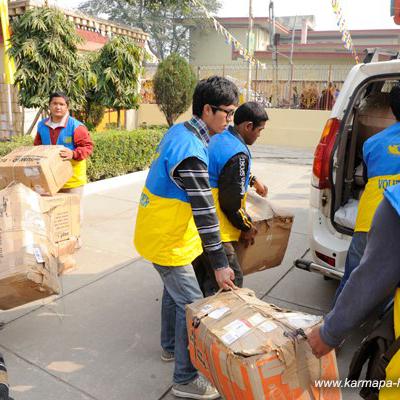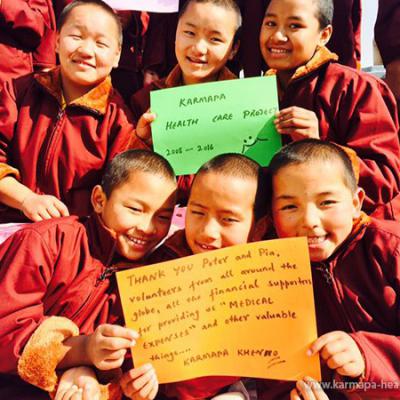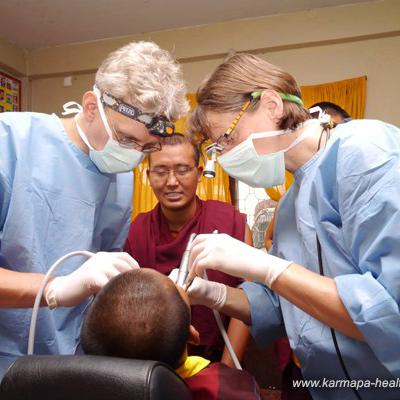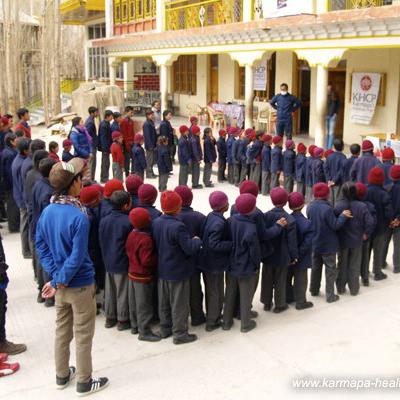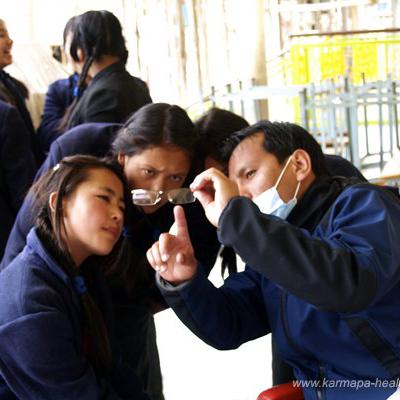"After Earthquake" Medical Tour Nepal Orphanages-Funds-Dhulikhel 2015-06
Our volunteers and team doctors from KHCP and Dhulikhel Hospital traveled to all of our Karma Kagyu orphanages and institutes in Nepal to assess the physical condition and immediate helps in terms of relief or and medical aids.
Here below the report of the diverse institutions of the Kathmandu area.
Donation AccountAccount Holder: KHCP e.V. |
|
|
Enlarge the pictures
by mouseover or click!
Sertshang Orphanage Home of Chogyal Rinpoche, Swayambhu/Kathmandu
Questionnaire. Sertshang Orphanage
Director: Chogyal Rinpoche
Key Person: Methok Dawa Sherpa
- No fatalities or injuries during the earthquake.
Medical condition:
Suspicion of tuberculosis could be dispelled. Dhulikhel Hospital is conducting further observations. Children received a health screening from Dr. Sonam. We found that many of the children are insufficiently vaccinated or not vaccinated at all. We discussed this matter with Chogyal Rinpoche, the director of the orphanage, who agrees to vaccinate the children. None of the children have suffered trauma.
Building condition:
Minimal damage was done to the building – only superficial cracks are visible. Apparently, engineers have examined the property and declared that there was no danger of the building collapsing. Nonetheless, the children are sleeping outdoors out of fear.
The SOH and the orphanage received joint funds of €6,500 for HIV infected children.
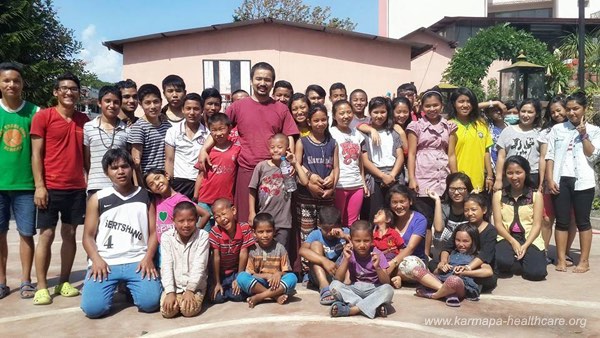 Chogyal Rinpoche and his orphans
Chogyal Rinpoche and his orphans
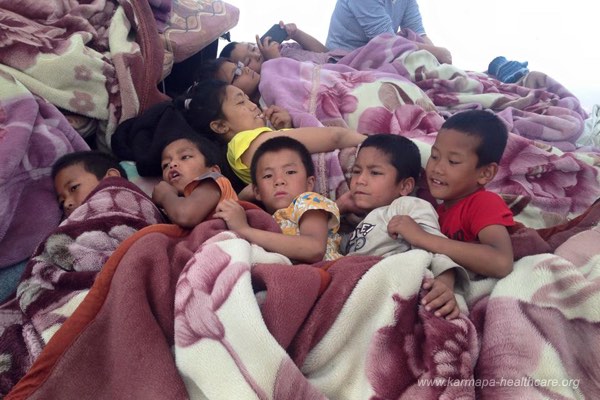 sleeping outdoor
sleeping outdoor
 Chogyal Rinpoche with KHCP physicians Dr. Angelika and Dr. Sonam
Chogyal Rinpoche with KHCP physicians Dr. Angelika and Dr. Sonam
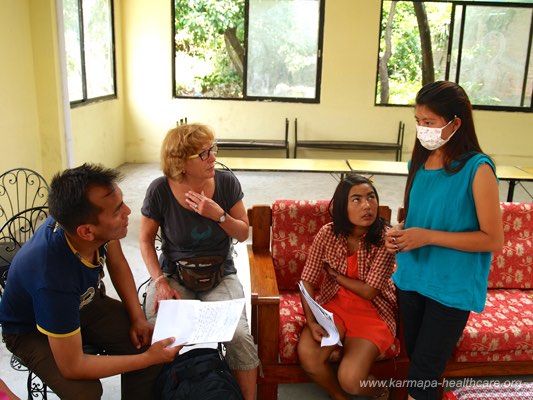 Meeting with the staff
Meeting with the staff
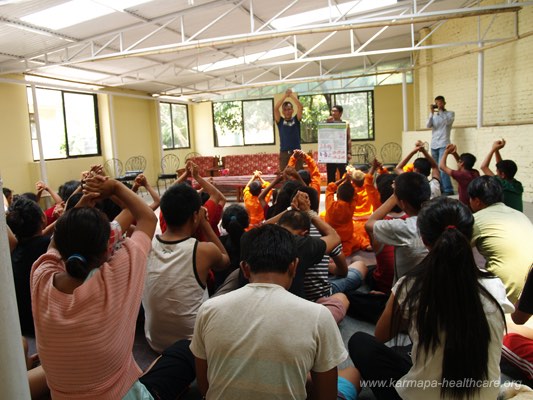 Health teachings with Dr.Sonam
Health teachings with Dr.Sonam
Orphanage Punarbac Plus of Chogyal Rinpoche, Swayambhu/Kathmandu
Questionnaire. HIV Orphanage of Chogyal Rinpoche
Director: Chogyal Rinpoche
- No fatalities or injuries during the earthquake.
Number of inhabitants: 27 children, of whom 21 are HIV positive
Medical and social conditions:
The director and founder of the orphanage informs us that those with the HIV infection are being stigmatised and discriminated against.
They have good medical care through the availability of medication and even a psychologist who visits the facilities and works with the children for four hours per week. The main expense is conducting HIV tests as these, unlike the medication, are not state-funded. Money for the orphanage to fund these tests is raised through Western organisations, one being situated in Switzerland. Chogyal Rinpoche also supports the orphanage by sponsoring the food. From now on, by linking the orphanage to Dhulikhel Hospital and by making donations, the KHCP will also offer regular support.
Building condition:
Some damage was caused to the building but it is not considered major. The water tank was destroyed in the earthquake. We decided to finance a new water tank up to the value of 15,000 rupees for which we received a receipt and the promise of a photograph of the installed water tank.
Orphanage Spark Children Home, Lalitpur, Kathmandu
Questionnaire. Sparks Children Home in Lalitpur
Directors: Brigitta and Willi Kröger
- no fatalities or injuries during the earthquake
Number of inhabitants:
13 children are currently living in the children’s home.
Medical and social conditions:
During the earthquake, two children were only mildly injured when a wall collapsed onto them. A boy broke his arm, but he is already recovering without the need for a cast. The second boy suffered from a laceration on his head, but he is also feeling well again. Other than that, the children are healthy and well looked after. Dr. Angelika and Dr. Sonam have examined them. One child has to go to Dhulikhel Hospital for a check-up.
Building conditions:
The building is not badly damaged. There is some repair work that has to be carried out on the top floor. A water tank has been placed in the courtyard while the water supply is interrupted and no clean drinking water is available.
Other:
The KHCP will cover the cost of €6,500 for the reconstruction of the building and to repair the water supply. The orphanage will also be supported by the KHCP in the future.
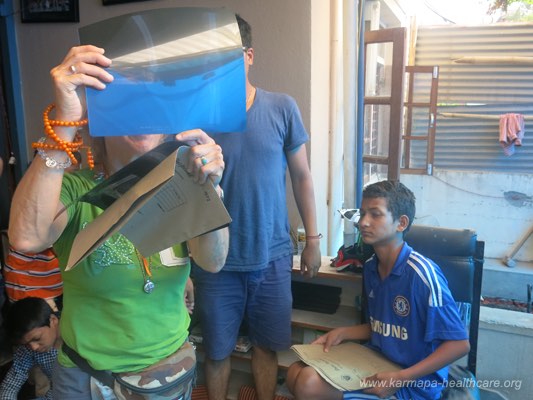 Screenings for the youngster
Screenings for the youngster
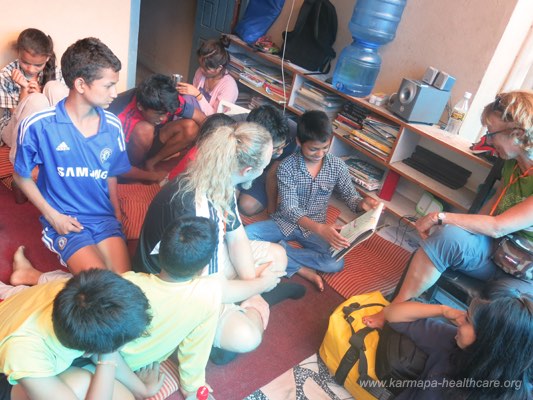 Health teachings
Health teachings
 Final group photo
Final group photo
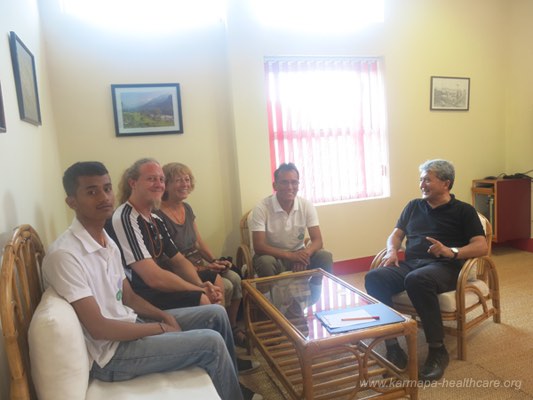 Interview with Dr. Ram Shestra
Interview with Dr. Ram Shestra
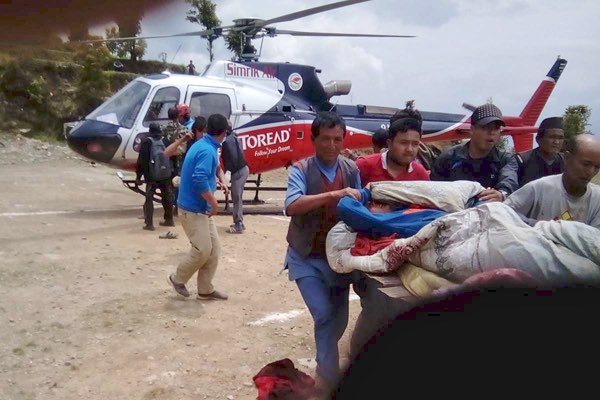 Urgent transports from remote areas
Urgent transports from remote areas
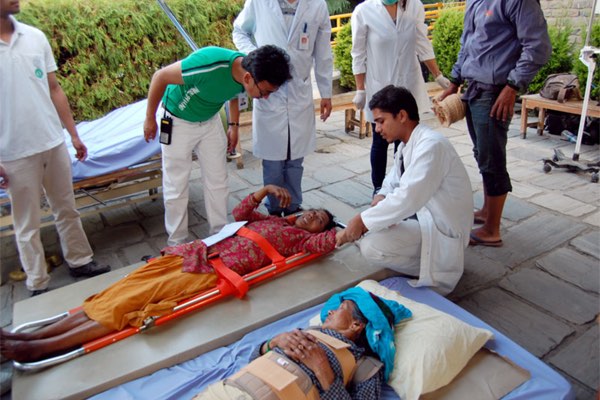 Improvisational emergency ward
Improvisational emergency ward
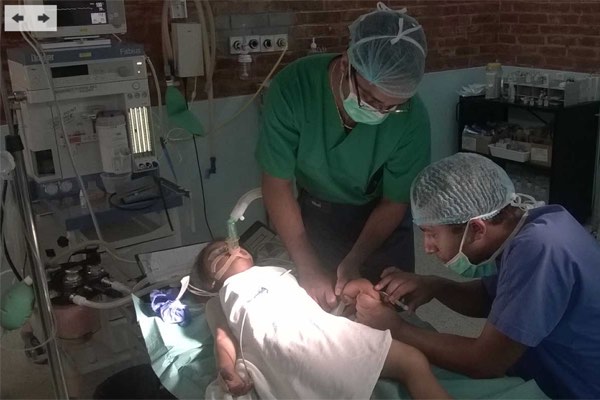 OPs with battery power
OPs with battery power
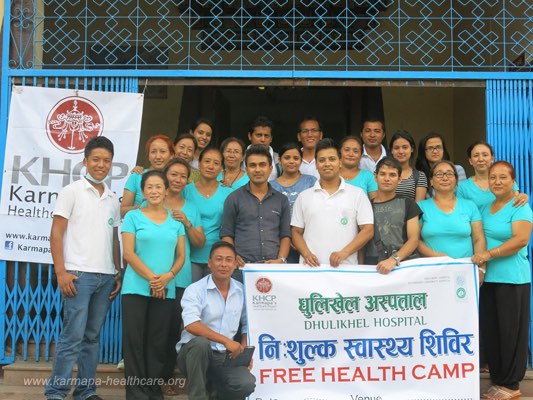 Free medical camp of KHCP/DHK
Free medical camp of KHCP/DHK
University Hospital Kathmandu in Dhulikhel (sponsored by KHCP)
Since 2012, a collaboration has developed between Dhulikhel Hospital Kathmandu with its Director Prof. Dr. Ram Sheestra and the KHCP. What was at first planned as a medical contact point has now developed to be a platform for a combination between medicine and social work.
The following is a short report of the activities of this collaboration after the earthquake in Nepal:
May. 27, 2015:
Interview of Dr Angelika Leist (KHCP) with Dr Ram Sheestra (director of the University Hospital Kathmandu in Dhulikhel) talking about the situation and the work after the earthquake.
Activity of the Dhulikhel Hospital and its 30 branches in the four weeks after the earthquake
Saturday, April 25 (Sunday in Nepal),
business as usual, only emergency staff 3 hours after the earthquake, about 500 employees on duty, despite breakdown of telecommunications and damage or destruction of 50% of the staff living quarters.
Life-saving operations started simultaneously in all of the nine operating theatres;
Staff working all shifts for 72 hours, with the occasional 1-2 hours of sleep from exhaustion;
After three days work resumed to 12-hour day and night shifts;
Most hospitals in the Kathmandu valley were shut down in the first two days.
People were brought in by helicopter, tractors, trucks, car and on foot; covered in debris and loam of the collapsed houses; lying dirty in beds, corridors, on the floor, cleaned with wet cloths or hosed down outside, showing coloured dots: green, yellow, orange and red, depending on the severity of the injuries; provided with number plates and treated free without registration.
About 3,000 large and small operations were conducted, mainly open and closed fractures, as well as cases of simple and multiple fractures of ribs and vertebrae; often with complications like haemorrhages in the chest or necessary amputations.
All earthquake victims were regarded as charity cases!
The number of treated patients in the hospital and its branches: 6,000
On April 28, today, there are still 450 inpatients, 300 of which were earthquake victims who were continued to be treated for free.
The patients’ family members received gratuitous meals from a tented outdoor kitchen.
Five big problems in the hospital during the catastrophe:
1. No electricity for three days in Dhulikhel; generators provided emergency power only for lighting in the operating theatres and patient rooms; not enough power for x-ray, CT or washing machines to clean the scrubs.
2. profound lack of water; complete breakdown of water supplies for hours, continuing to this day
3. no communications due to power failure, landlines down, mobile networks rebooted after a few hours
4. traffic chaos: roads leading to hospital were blocked by vehicles for a long time
5. shelters: in the face and fear of aftershocks accommodations at ground level in scarce supply; up to May 22, there were 250 !!!! smaller earthquakes with magnitudes of above 4 on the Richter scale.
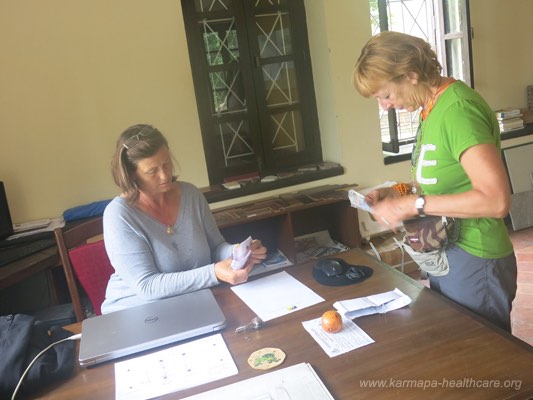 Handover the money
Handover the money
Karmapa Sharmanag Committee, Kathmandu (sponsored by KHCP)
The KHCP-Medteam had a meeting at Sharminub Center.
KHCP transfered € 20.000 to support their aid campaigns in the remote areas of Nepal.
Foot, prefabricate huts and diverse materials could be delivered to several villages.
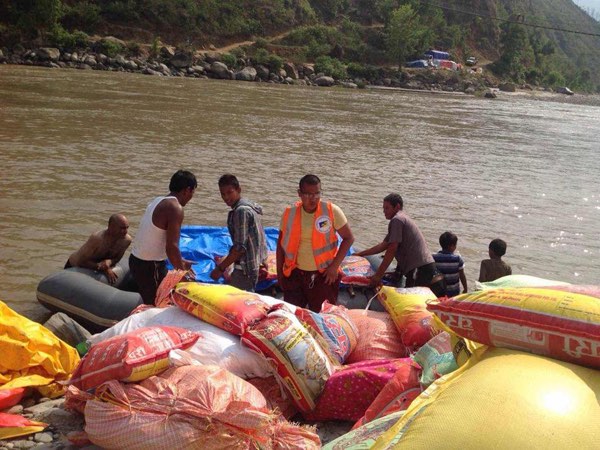 Relief campaigns to remote areas
Relief campaigns to remote areas
 Relief campaigns to remote areas
Relief campaigns to remote areas
Manang Trust
Manang Gompa of Sherab Gyaltsen Rinpoche,
under supervision on Manang Trust
Meeting with the Manang Social Service Community/Manang Trust:
It is like a miracle that nobody was hurt at the collapse of the Manang Gompa. At the time of the collapse, a festival was taking place outdoors, whereby nobody was inside the Gompa during the earthquakes. The building was completely destroyed. The Manang Social Service Community has already started to plan the rebuilding. The new Gompa is to accommodate 2,500 people and its construction is to be safe from earthquakes! Sherab Gyaltsen Rinpoche will decorate the building personally.
The cost for the reconstruction of the Gompa is estimated to exceed €1,000,000 and take 2 years to complete. The building costs are covered exclusively by donations.
The KHCP has agreed to donate €10,000 as we have been using a clinic room that is located on the grounds of the Manang Gompa for many years, and this way we have been able to treat many people.
KHCP Medteam’s meeting with Sherab Gyaltsen Rinpoche
In the evening, we meet Sherab Gyaltsen Rinpoche who thanked us and blessed us for our activities.
When we asked him how the KHCP could support him. He immediately responded that the reconstruction of the Manang Gompa of the monastery of Nala was of the utmost importance.
He asked for the KHCP to collect donations for this purpose, but we are already doing this!
 KHCP with Manang committee president Mr Man Bdr Gurung, Khanda Gurung (president womens society), Eden Gurung (vice president women society).
KHCP with Manang committee president Mr Man Bdr Gurung, Khanda Gurung (president womens society), Eden Gurung (vice president women society).
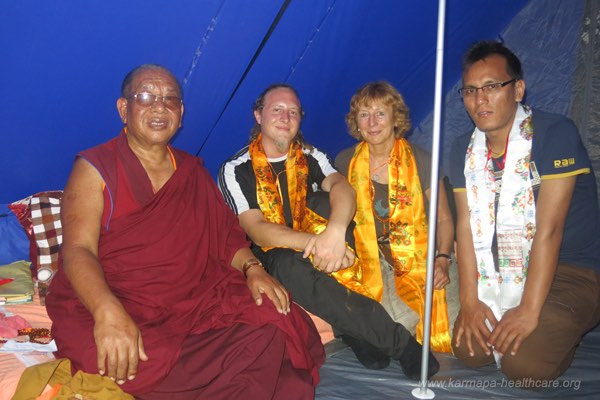 Sherab Gyaltsen Rinpoche with KHCP medics
Sherab Gyaltsen Rinpoche with KHCP medics
 Sherab Gyaltsen Rinpoche´s Manang gompa previous/after earthquake
Sherab Gyaltsen Rinpoche´s Manang gompa previous/after earthquake
Donation AccountAccount Holder: KHCP e.V. |
|
|

